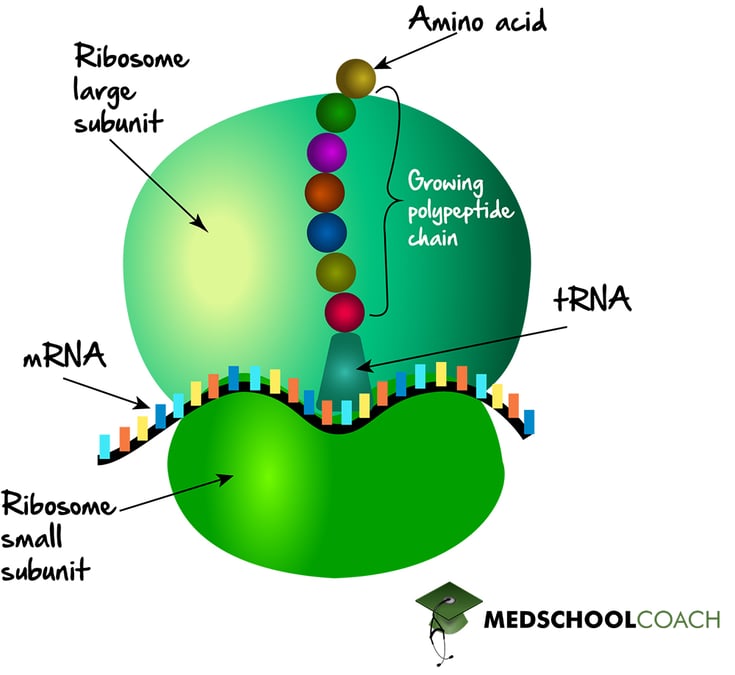Sample MCAT Question - Ribosome Structure & Function
Which prokaryotic ribosomal subunit is correctly associated with its sedimentation coefficient (s)?
a) Large subunit: 60s
b) Combined subunits: 80s
c) Small subunit: 40s
d) Large subunit: 50s
Get 1-on-1 MCAT Tutoring From a Specialist
With MCAT tutoring from MedSchoolCoach, we are committed to help you prepare, excel, and optimize your ideal score on the MCAT exam.
For each student we work with, we learn about their learning style, content knowledge, and goals. We match them with the most suitable tutor and conduct online sessions that make them feel as if they are in the classroom. Each session is recorded, plus with access to whiteboard notes. We focus on high-yield topics if you're pressed for time. If you have more time or high-score goals, we meticulously cover the entire MCAT syllabus.
Ribosome Structure and Function
Before you can understand the process of translation, it is first essential to understand the structure of ribosomes. Ribosomes are molecular complexes made up of both ribosomal RNA and ribosomal proteins. These RNA-protein complexes are responsible for translating mRNA into proteins. Within the cell, ribosomes can be found either in the cytosol as free ribosomes or bound to the rough endoplasmic reticulum, as membrane-bound ribosomes. The type of ribosome used to translate a protein depends on the type of protein that needs to be translated.
For example, cytosolic proteins are translated by free ribosomes, whereas proteins found in the membrane of the cell are translated by membrane-bound ribosomes on the rough ER. Figure 1 shows a ribosome. Notice how it is made up of two subunits. There is a small subunit, as well as a large subunit. As the mRNA is translated, it will be sandwiched between the subunits. For the MCAT exam, it is important to know the difference between prokaryotic and eukaryotic ribosomal subunits.

Prokaryotic vs Eukaryotic Ribosomal Subunits
Both prokaryotic and eukaryotic ribosomes have one large and one small subunit. The unit of each subunit is denoted by S, which measures the sedimentation rate of each subunit derived from centrifugation. For the MCAT exam, it is not important to understand the derivation process of the S-values. However, it is important to know which S-values correspond to which subunits on prokaryotic and eukaryotic ribosomes.
For prokaryotes, the small subunit is 30S, and the large subunit is 50S. The combined ribosome is 70S. Contrastingly, in eukaryotes, the small subunit is 40S, and the large subunit is 60S. The combined ribosome is 80S. It is interesting to note that several antibiotics work by targeting the various ribosomal subunits in prokaryotes and disrupting translation. The antibiotics will not harm eukaryotic ribosomal subunits because the structures are so different.
A useful tool to help remember the size of prokaryotic and eukaryotic ribosomes and their subunits is that Eukaryotic sizes are all Even numbers (40, 60, and 80S).
Explore More
MCAT Masterclass Chapters
Take a closer look at our entire MCAT Masterclass or explore our Biology lessons below.
-
MCAT Biology
Translation
View Subject -
MCAT Biology
Post-Translational Modification of Proteins
View Subject -
MCAT Biology
Mechanism of Transcription
View Subject -
MCAT Biology
Operons & Prokaryotic Gene Expression Part 1
View Subject -
MCAT Biology
Operons & Prokaryotic Gene Expression Part 2
View Subject -
MCAT Biology
Eukaryotic RNA Processing & Splicing
View Subject




